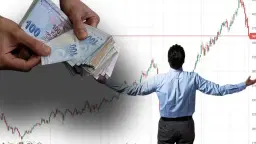If Turkey’s gold exports were one million dollar lower; growth rate would be 2.6 percent instead of 3.2 percent.
Recent changes in domestic demand have verified the analysis covered in a number of commentaries on this column before the gross domestic product (GDP) figures were announced. As was implied by several indicators, domestic demand grew year-on-year only by 0.9 percent in the first quarter. On the other hand, net foreign demand contributed to growth more than I expected. GDP thus grew by 3.2 percent in the first quarter of the year.
Exports were determinant
Imports decreased and net foreign demand increased. What triggered net foreign demand growth was the strong rise in the export of goods and services, however: year-on-year export growth by 13.2 percent is almost record-high. “Almost” because stronger growth figures had been recorded before. But between 1999 and 2012, export growth was higher than 13.2 percent only six times. There are many indicators that the rise in domestic demand remained weak also in the second quarter of the year. Therefore, GDP growth in quarter two also will be determined by the export performance. Union of Turkish Exporters (TİM) has recently announced export developments for the first half of the year. According to this, in the second quarter exports increased by 2.5 percent year-on-year while year-on-year growth in exports in the first quarter was 9 percent.
But please note that exports as recorded in GDP accounts differ from export figures announced by the TİM in two aspects. First, the latter does not cover gold exports. Second, the former involves export of services, tourism revenues for instance, while the latter does not. I would like to set aside services and focus on gold exports. Major changes have been observed in the non-monetary gold component in the balance of payments account as well as the relevant components of the export figures compiled by the Turkish Statistical Institute (TURKSTAT). In general, Turkey is a net gold importer. During the global crisis (particularly in 2009) Turkey was a net gold exporter. So it was in the first five months of 2012. If we focus solely on exports, we see that gold exports have increased by $3.7 billion in the first five months of the year compared to the same period in 2011. Out of this amount, $2.6 billion was recorded in April and May, that is, the second quarter of the year.
Gold exports trigger growth
Of course there is nothing odd here. As an open economy, it is just natural to trade gold. A recent analysis by Uğur Gürses at Radikal daily stresses that this upwards trend in gold exports will most likely be temporary. I am rather interested in the repercussions of this movement on GDP growth. So, here is the question: If gold export was at its “normal” level in the first quarter of 2012, how would GDP growth rate change?
I will skip details and just give the results of this non-precise calculation: If Turkey’s gold exports were one million dollar lower; growth rate would be 2.6 percent instead of 3.2 percent. Of course if gold exports were equivalent to gold imports, growth outlook would not change. However, the “abnormal” rate of increase in imports that was observed in 2011 does not apply for 2012. Therefore, without the temporary changes in gold imports and exports, 2011 growth would have been slightly higher and 2012 first quarter growth would have been slightly lower. The rise in gold exports in April and May were marginally higher than it was in the first quarter. In April, gold imports also increased. Still, net gold export is pretty stronger, compared to the first quarter of the year. If net gold exports remain in the positives in June, the difference will widen.
So, here is the moral of the story: temporary rise in exports continues and will make a stronger contribution to growth in the second quarter, compensating for the weak growth in non-gold goods exports. Hence, growth rate in the second quarter will not be lower than that in the first quarter.
This commentary was published in Radikal daily on 07.07.2012





